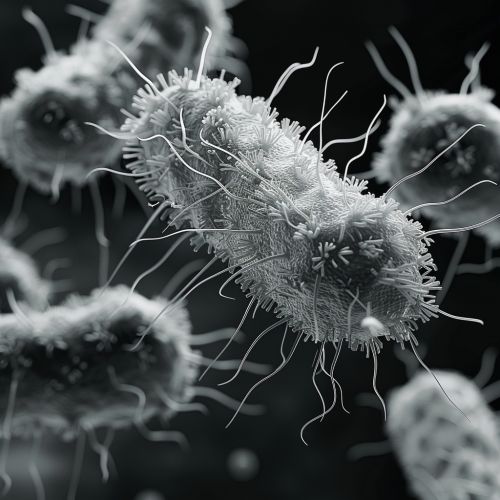Pilus
Structure and Function
A pilus (plural: pili) is a hair-like appendage found on the surface of many bacteria. The term 'pilus' is derived from Latin, meaning 'hair'. Pili are typically 5-10 nanometers in diameter and can be several micrometers long. They are composed primarily of pilin proteins and are assembled by the action of specific secretion systems.


Pili serve several functions in bacteria, including motility, DNA transfer, and adherence to host tissues. The role of pili in bacterial motility is often referred to as 'twitching' motility, as the movement is jerky and non-directional. This type of motility is observed in bacteria such as Pseudomonas aeruginosa and Neisseria gonorrhoeae.
In the process of DNA transfer, also known as conjugation, a specific type of pilus, the F-pilus, plays a crucial role. The F-pilus attaches to a recipient bacterium and pulls it closer, allowing for the transfer of a plasmid (a small, circular piece of DNA) from the donor bacterium to the recipient. This process is a major mechanism of horizontal gene transfer in bacteria, contributing to genetic diversity and the spread of antibiotic resistance.
Pili also play a key role in bacterial pathogenesis, as they enable bacteria to adhere to host tissues. This adherence can prevent the bacteria from being washed away by bodily fluids and helps them to establish an infection. For example, the Type 1 pili of Escherichia coli bacteria are critical for their ability to cause urinary tract infections.
Types of Pili
There are several types of pili, each with distinct structures and functions. The major types include the F-pili (or sex pili), Type 1 pili, and Type IV pili.
F-pili are involved in bacterial conjugation and are typically longer and fewer in number than other types of pili. They are found in Gram-negative bacteria that possess the F (fertility) plasmid.
Type 1 pili are involved in adherence to host tissues and are found in a variety of Gram-negative bacteria, including Escherichia coli and Klebsiella pneumoniae. These pili have a unique 'tip adhesin' protein that recognizes and binds to specific molecules on the surface of host cells.
Type IV pili are involved in twitching motility and adherence to host tissues. They are found in a wide range of bacteria, including Pseudomonas aeruginosa and Neisseria gonorrhoeae. Type IV pili are unique in their ability to extend and retract, which enables the bacteria to move and to pull themselves closer to host tissues.
Biogenesis of Pili
The biogenesis of pili involves a complex process of protein secretion and assembly. The pilin proteins that make up the pilus are synthesized in the cytoplasm of the bacterium and are then transported across the inner membrane by the Sec (secretion) system. Once in the periplasm, the pilin proteins are assembled into a pilus by the action of a dedicated pilus assembly system.
For F-pili and Type IV pili, the assembly system is a type of Type II secretion system, while for Type 1 pili, it is a chaperone-usher pathway. These systems recognize specific signals in the pilin proteins and assemble them into a pilus in a precise, stepwise manner.
Pili in Bacterial Pathogenesis
Pili are critical virulence factors in many bacterial pathogens. They enable the bacteria to adhere to host tissues, resist host defenses, and establish an infection. In some cases, the pili can also damage host tissues directly, by triggering inflammatory responses or by transferring toxins.
For example, the Type 1 pili of Escherichia coli are essential for the bacteria to cause urinary tract infections. The pili enable the bacteria to adhere to the cells lining the urinary tract, preventing them from being washed away by urine. The bacteria can then multiply and invade the host tissues, causing infection.
Similarly, the Type IV pili of Neisseria gonorrhoeae are critical for the bacteria to cause gonorrhea. The pili enable the bacteria to adhere to the cells lining the genital tract, resist the host immune response, and establish an infection.
